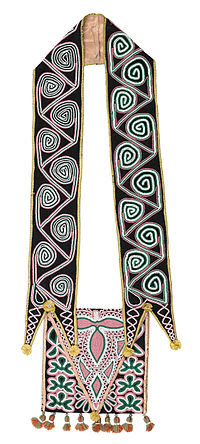
Back شعب مسكوكي Arabic Muskoqlar Azerbaijani Маскогі (народ) Byelorussian Мускоги Bulgarian Creek Catalan Kríkové Czech Muscogee Welsh Creek Danish Muskogee (Volk) German Creek Spanish
This article needs additional citations for verification. (July 2024) |
 | |
| Total population | |
|---|---|
| 2010: self-identified 88,332 alone and in combination[1] | |
| Regions with significant populations | |
| United States (historically Alabama, Georgia, Mississippi, Florida, and Tennessee; now primarily Oklahoma and Alabama) | |
| Languages | |
| Muscogee, Hitchiti-Mikasuki, and English | |
| Religion | |
| Protestantism, Four Mothers Society, and others | |
| Related ethnic groups | |
| Yuchi, Muskogean peoples: Alabama, Koasati, Miccosukee, Yamasee, Chickasaw, Choctaw, Coushatta, Mascogos, and Seminoles |
The Muscogee, also known as the Mvskoke, Muscogee Creek or just Creek, and the Muscogee Creek Confederacy (pronounced [məskóɡəlɡi] in the Muscogee language; English: /məsˈkoʊɡiː/ məss-KOH-ghee), are a group of related Indigenous peoples of the Southeastern Woodlands[2] in the United States. Their historical homelands are in what now comprises southern Tennessee, much of Alabama, western Georgia and parts of northern Florida.[3]
Most of the Muscogee people were forcibly removed to Indian Territory (now Oklahoma) by the federal government in the 1830s during the Trail of Tears. A small group of the Muscogee Creek Confederacy remained in Alabama, and their descendants formed the federally recognized Poarch Band of Creek Indians. Another Muscogee group moved into Florida between roughly 1767 and 1821, trying to evade European encroachment,[4] and intermarried with local tribes to form the Seminole. Through ethnogenesis, the Seminole emerged with a separate identity from the rest of the Muscogee Creek Confederacy. The great majority of Seminole were forcibly relocated to Indian Territory in the late 1830s, where their descendants later formed federally recognized tribes. Some of the Seminole, with the Miccosukee moved south into the Everglades, resisting removal. These two tribes gained federal recognition in the 20th century and remain in Florida.
The respective languages of all of these modern-day branches, bands, and tribes, except one, are closely related variants called Muscogee, Mvskoke and Hitchiti-Mikasuki, all of which belong to the Eastern Muskogean branch of the Muscogean language family. These languages are mostly mutually intelligible. The Yuchi people today are part of the Muscogee (Creek) Nation, but their Yuchi language is a linguistic isolate, unrelated to any other language.[5]
The ancestors of the Muscogee people were part of the Mississippian Ideological Interaction Sphere, also known as Mississippian cultures. Between 800 and 1600 CE, they built complex cities with earthwork mounds with surrounding networks of satellite towns and farmsteads. Muscogee confederated town networks were based on a 900-year-old history of complex and well-organized farming and town layouts around plazas, ballparks, and square ceremonial dance grounds.
The Muscogee Creek are associated with multi-mound centers, such as the Ocmulgee, Etowah Indian Mounds, and Moundville sites. Precontact Muscogee societies shared agriculture, transcontinental trade, craft specialization, hunting, and religion. Early Spanish explorers encountered ancestors of the Muscogee in the mid-16th century.[6]
The Muscogee were the first Native Americans officially considered by the early United States government to be "civilized" under George Washington's civilization plan. In the 19th century, the Muscogee were known as one of the "Five Civilized Tribes", because they were said to have integrated numerous cultural and technological practices of their more recent European American neighbors.
Influenced by Tenskwatawa's interpretations of the 1811 comet and the New Madrid earthquakes, the Upper Towns of the Muscogee, supported by the Shawnee leader Tecumseh, actively resisted European-American encroachment. Internal divisions with the Lower Towns led to the Red Stick War (Creek War, 1813–1814). Begun as a civil war within Muscogee factions, it enmeshed the Northern Muscogee bands as British allies in the War of 1812 against the United States, while the Southern Muscogee remained US allies. Once the northern Muscogee Creek rebellion had been put down by General Andrew Jackson with the aid of the Southern Muscogee Creek, the Muscogee nation was forced to sign the Treaty of Fort Jackson, which ceded 22,000,000 acres of land to the US, including land belonging to the Southern Muscogee who had fought alongside Jackson.[7] The result was a weakening of the Muscogee Creek Confederacy and the forced cession of Muscogee lands to the US.
During the 1830s Indian Removal, most of the Muscogee Confederacy were forcibly relocated to Indian Territory. The Muscogee (Creek) Nation, Alabama-Quassarte Tribal Town, Kialegee Tribal Town, and Thlopthlocco Tribal Town, all based in Oklahoma, are federally recognized tribes. In addition, the Poarch Band of Creek Indians of Alabama, the Coushatta Tribe of Louisiana, and the Alabama-Coushatta Tribe of Texas are federally recognized. Formed in part originally by Muscogee refugees, the Seminole people today have three federally recognized tribes: the Seminole Nation of Oklahoma, Seminole Tribe of Florida, and Miccosukee Tribe of Indians of Florida.
- ^ "2010 Census CPH-T-6. American Indian and Alaska Native Tribes in the United States and Puerto Rico: 2010" (PDF). census.gov. Retrieved February 7, 2015.
- ^ Transcribed documents Archived February 13, 2012, at the Wayback Machine Sequoyah Research Center and the American Native Press Archives
- ^ Fogelson ix
- ^ Mahon, pp. 187–189.
- ^ "Yuchi/Euchee". Omniglot. Retrieved May 30, 2018.
- ^ Walter, Williams (1979). "Southeastern Indians before Removal, Prehistory, Contact, Decline". Southeastern Indians: Since the Removal Era. Athens, Georgia: University of Georgia Press. pp. 7–10.
- ^ Brands, H. W. (2005). Andrew Jackson: His Life and Times. New York: Knopf Doubleday Publishing Group. pp. 233–235. ISBN 978-1-4000-3072-9.